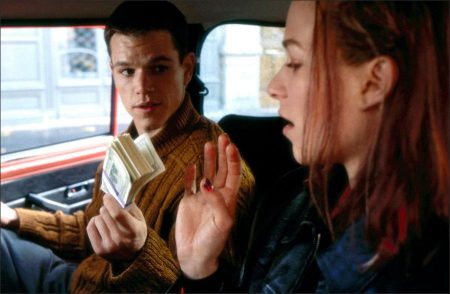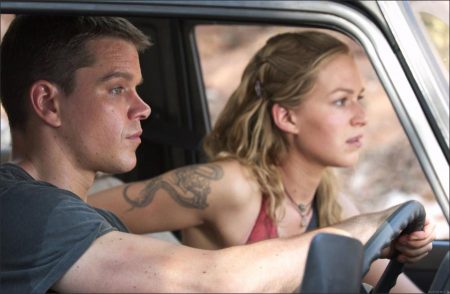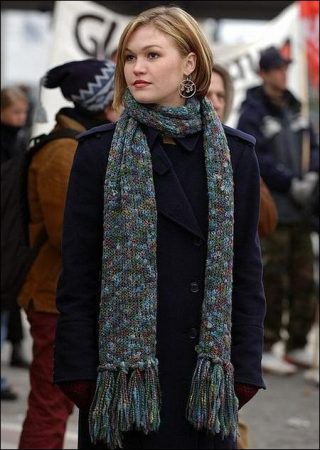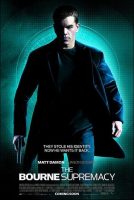With the runaway, international success of 2002′s The Bourne Identity, the world had been re-introduced to not only the character of trained assassin Jason Bourne (memorialized in Robert Ludlum’s best-selling books), but to an anomaly that summer moviegoers crave-a blockbuster with both style and substance. By transplanting Bourne from the Cold War setting of the novels to the Europe of the post-Wall collapse, an intriguing anti-hero was dusted off and brought into the new millennium.
“We made an intellectual spy film, a paranoid thriller, but we did it in an unconventional way,” remembers producer Frank Marshall. “Putting Matt in the lead was casting against type, and he turned out to be the perfect choice-a non-traditional action hero was born in that film. He’s proved so compelling that we wanted to continue his story.”
Matt Damon remembers, “I was not the first person to come to mind for a project such as The Bourne Identity. I had to overcome that I look young, that I don’t necessarily look like a stone cold killer. But by playing against expectation, I felt like it was a real chance to do something different than I’d seen in other action movies. We worked very hard to tie me into as many of the situations and stunts as possible, to give my performance believability.”
Robert Ludlum’s The Bourne Supremacy, the second in his successful series of spy thrillers featuring trained assassin Jason Bourne, was published in 1986. It spent 25 weeks on The New York Times Best-Seller List with eight weeks at #1.
Veteran film producers Marshall and Patrick Crowley were committed to the innovative storytelling and unconventional approach which led their first film to global box office success and on to become the number one home video/DVD rental of 2003. The taut suspense and character-driven action of The Bourne Identity were achieved through a variety of elements that they were determined to bring back-to pump new life into the time honored espionage thriller.
They needed to keep fresh the take on Robert Ludlum’s classic story about an amnesiac trained assassin who is slowly waking to the reality of his past. So Marshall and Crowley worked with screenwriter Tony Gilroy to come up with a story worthy of the journey Jason Bourne embarked on in the first film.
Frank Marshall comments, “We did not set out to make a sequel. What worked so well in the first film was that so much of it was unexpected-casting against type, going for something beyond a chase and action movie. So if your goal is to make a sequel to that, you’ve just defeated yourself because it’ll be expected.”
“One of the things that always impressed us in all the early screenings of Bourne Identity,” says producer Patrick Crowley, “is people would say `Wow, I really appreciate that you made us think, that you didn’t tell us what was going on.’ And you kind of have to deliver the same goods again, but it has to be better this time.”
Damon observes, “We held to the idea that the action is always developing the character, that it grows right out of the story. We really wanted to build a story where the action was integrated into the characters and their situations-so that you might be able to believe that these are kind of ordinary people pushed into extraordinary circumstances. It sort of defies the customary action formula, and I feel it’s one of the compelling things about Bourne’s continuing story.”
Having left Jason and Marie finally safe and in a sunny seaside village on the coast of Greece, the filmmakers needed to find a way of starting up the story again. “Quite simply, we needed to find a way to get Jason Bourne back in the fray,” says producer Marshall, “but we weren’t interested in the standard revenge tale. While that does play a part in it, we were looking for something more.”
Picking Up the Thread
From the outset, the Bourne stories presented certain challenges to the filmmakers. Ludlum’s immensely popular books were written against the backdrop of the Cold War, with the looming presence of the infamous international terrorist called Carlos. But as Ludlum’s long-time friend and literary agent Henry Morrison explains, “The Cold War, per se, was not the important thing to him. It was what was happening to people, and how multinational companies and governments were beginning to manipulate and restrict people. That was what he was writing about.”
The success of the fist film is a testament to the durability of Ludlum’s enigmatic central character and the ability of the filmmakers to present a new kind of action hero in a fresh type of action movie. The filmmakers had proven that they could successfully take Bourne out of the Cold War and transport him into a 21st century world where black-and-white villains and heroes no longer exist.
As with the first film, they borrowed a plot point from Ludlum’s story to serve as a springboard, this time for Jason Bourne’s return. “There was an incident with Marie in the second book where she gets kidnapped and held as a ransom in order to force him back,” Frank Marshall explains the kernels of the second story. “And there was a line in the first film when he threatens to come after them if they ever come near him again.”
Starting with little more than those two ideas, screenwriter Tony Gilroy took a chance. “We didn’t want to do another film if we couldn’t do something really cool,” Gilroy explains.
Actor Matt Damon concurs, “When The Bourne Identity came out I said, `There is very little chance we will do a second film, just because nobody on the team who made the first wants to make another movie if it can’t be as good as, or better than, the first one.’”
“We knew we had to do something pretty radical,” says Marshall of what was needed to capture the momentum of the first film, “and then Tony came up with this amazing idea that Jason Bourne would go on what amounts to the samurai’s journey, this journey of atonement.”
“In terms of Tony veering away from the plot of the book, it’s true,” notes producer Paul L. Sandberg. “We kept the character, his initial predicament, the feel of the story-but we had to change the story, Bourne’s journey, because so much of the world has changed since the book’s publication.”
If filmmakers were going to make another film with Bourne at the center, everyone had to be convinced it was worthwhile. “I wrote a long letter to Matt,” Gilroy recalls, “and explained why we couldn’t do the normal things you would do in a movie like this.You can’t have a revenge movie because Jason Bourne is an assassin-Jason Bourne killed people and he doesn’t start the movie with a clean slate. There’s a lot of blood on his hands, so a revenge movie didn’t feel right. He wasn’t healed yet, all he did was say, `Wow, I know who I am, I know what I did, and I don’t want to do that anymore.’ But is that enough? So that was a starting point for Supremacy.”
For Damon, Gilroy’s ideas for the second film evolved naturally from the first. “You see him continue on this journey that he started on when he got pulled out of the sea in the first one. This was the logical direction for him to keep going as he continues trying to reintegrate himself into the human race.”
With the outline for a compelling story and the script underway, everyone knew that now the key factor in bringing the film together was finding the right director.
“Tony told me to look at a movie called Bloody Sunday,” recalls producer Frank Marshall. “He said that it had a verisimilitude, a reality to it, that made you feel like you were right in it. We went out and got the movie and thought it was fantastic.”
Bloody Sunday is British director Paul Greengrass’ dynamic recreation of January 30, 1972 in Derry, Northern Ireland, when a peaceful civil rights march ended in bloodshed; the film won numerous awards worldwide, including the Berlin Film Festival’s Golden Bear and the Audience Award at the Sundance Film Festival. Greengrass had a visual style with an edgy immediacy that was perfect for Bourne.
Crowley, who has a background in documentaries, was impressed with Greengrass’ film. “I was really knocked out by it. He knew how to create scenes that looked as if they’d been achieved spontaneously and realistically. His sense of the camera as participatory viewer really suited the continuation of Jason’s story-his visual style matches with the anti-hero, the gritty very realistic settings, the lack of customary Hollywood story beats in Supremacy.”
“I liked Bourne Identity,” Greengrass recalls, “I went on a date to see it, on the spur of the moment. It was a fresh-looking film, one that really married an independent sort of feel with a mainstream Hollywood sensibility.”
Producer Sandberg notes, “Paul Greengrass brings a willingness to approach things from a non-standard fashion, which has proved to be key to the Bourne series. He comes in as a European outsider, if you will, and that informs everything he does-from how he lights his shots to how he motivates his actors. He really stepped up to the plate in collaborating with all of the creative participants, discussing his vision with Tony and helping to formulate and reformulate to bring out what he felt was important as a director simultaneously with what Matt felt was important for the character.”
To the director, who started his career as an investigative journalist and award-winning documentary and feature-film director, the idea of doing something totally different was intriguing. “I was wanting a bit of adventure in life and feeling that I’d done a few films of similar type. Sometimes you need to kind of do something totally different to find out what it’s like, totally new actors, totally new technicians-it’s good for you and it teaches you something.”
Greengrass flew to Prague to meet with actor Matt Damon, who was shooting there. “The genius of the franchise, and I do think of it as a genius of a franchise,” explains the director, “is Matt Damon playing Jason Bourne. He is an utterly fresh character and that’s what Matt brings to it-because everybody knows Matt is basically a good guy in terms of personae. He projects goodness. So then if you create a character who is basically a very dark character, a contract killer, with all the capabilities of a contract killer, and point him toward the light and get Matt Damon to play it, you’ve got an absolutely compelling character.”
“Unconsidered” is the word Greengrass uses to describe the quality he wanted to bring to the film; it was what he looked for in every aspect of the filmmaking, particularly in the way the camera was employed. “I think that one of the things that made the first film fresh,” he says, “is that it was quite lose with a little bit of handheld in there and it wasn’t straightforward, conventional storytelling. I think the story needs to feel like it’s unfolding against a clock in a short timeframe and I think you need to feel like Bourne is leading you through this film.
“It’s the difference between a knowing and an unknowing camera,” the director continues. “A knowing camera is telling the story, because it knows where the action is going to be. And I think what’s appropriate for this film is that the camera tells the story because it’s reacting to what’s in front of it. Both are contrivances because the truth is you don’t just turn up and react, you need to judge it, but the net effect is to create a visceral urgency, a sense of immediacy.”
Adds Damon, “Paul Greengrass really understands the character of Jason Bourne, the fact that he’s a guy-even though he happens to be a trained assassin-who is swept up in these puzzling circumstances that force him down a certain path. I thought Bloody Sunday was one of the best films in recent years. Paul’s ability to capture the classic `man versus the world’ conflict in a cinematically distinctive style is remarkable.”
Greengrass notes, “I think this film is not so much about a man who’s lost his memory, although that is a part of it-but it’s more about what happens when you’ve recovered your memory and realized that you’re actually a bad man.”
Spy Vs. Spy
Jason Bourne attempted to walk away from a world that refuses to stay neutral. The forces at work have now pulled him back in and he is once again confronted by a cadre of familiar (as well as new) faces-nearly all of them unwelcome.
German actress Franka Potente returns as Marie, the source of benevolence and light that continues to prove key to Bourne’s acceptance of his past and his attempts to move beyond it.
Observes Potente, “Two years have passed since Jason and Marie ended up on that beach in Greece. While it’s clear that Jason isn’t totally healed, he is at least incredibly committed to the relationship and the softening influence of Marie. It’s very much been a choice on their part. The flashes from the past continue, which cause ripples in their life, but they’ve chosen to stay put… until Jason’s nightmares actually materialize, and they’re forced to run again.”
Greengrass observes, “Marie is the hope that a new page can be turned in his life, and Franka brings both a strength and a feeling of redemption to this very dark world of Jason’s.”
One of the key players reinforcing that darkness is Ward Abbott, whom the director characterizes as “a bureaucratic controller of dark secrets,” embodied by leading character actor Brian Cox. Greengrass says, “Brian brings all of the colors anyone could ask for in a plausible adversary-he can sinuous and he can be bullying; he can be cunning and he can be self-dramatizing; he can be pathetic and frightening and sinister. There’s a whole spectrum in-between the poles of black and white that Brian inhabits brilliantly.”
“Clearly in this new world far removed from the Cold War,” supplies Cox, “Abbott is a bit of a dinosaur, an old-school kind of guy. Now, so much of the game is about political use or abuse of intelligence, no longer so much of `agency-as-independent-entity,’ accountable to no one. The operation that spawned Bourne, Treadstone, has been dismantled. Abbott is, in some ways, the lord of a shrinking fiefdom, and truth be told he’s not very pleased about that.”
Bourne isn’t the only one brought back into the ever-shifting world of international political intrigue. Nicky, the field agent whose work within Treadstone provided perhaps the only human face to the cold operation, is called in by Abbott-to act as go-between for Bourne and the CIA and, inadvertently, as a sympathizer with Jason-as she was the last one to see Bourne alive. Returning in the role is Julia Stiles.
Producer Marshall observes, “It’s really been interesting to see how people have matured between the first film and this. Julia was in college when we filmed the first one, and she’s really grown and matured an actress. That reflects on the character of Nicky, who’s grown up within the agency, and really adds to it. Julia proves to be a great asset to this chapter in our story.”
“In many ways, I think Nicky was in over her head when we first met her,” observes Stiles on her returning character. “But now that she’s been pulled back, she realizes that the information she has actually empowers her and puts her on more equal footing with Abbott and the upper echelon. She understands the negative effect that Treadstone had on its operatives as human beings. She sees Bourne as a casualty of this operation. She’s torn between carrying out the orders of her bosses, whom she does not trust, and helping Jason, who basically saved her life. It’s an interesting predicament that only adds to the `who’s the good guy here?’ situation.”
Clearly not a good guy is the new character of Kirill, a rival assassin whose alliances remain shadowy, due in part to the fact that he is not someone who could be called “verbose.” Flipping from the heroic role of Rohan warrior Eomer in The Lord of the Rings trilogy to this cold-blooded killer-for-hire is Karl Urban.
“Karl has done a tremendous job at bringing a fully rounded performance to a role that doesn’t have many lines,” says Greengrass. “He’s incredibly precise as an actor, both in his choices and in his physical actions. Kirill called for a lot of challenging stunt driving, and Karl was incredibly accurate. He’s taken the character’s moments and fully invested in them, making each and every one of them matter.”
Urban says, “This character, Kirill, doesn’t say a hell of a lot, but what he does speaks volumes. I mean, usually you do a film where you work on a project and it’s cluttered with dialogue, sometimes too much dialogue, and so it was really lovely to come to work and have it stripped back to the raw essence. This character is sort of a throwback to some of the noir characters, the noir hit men in classic French films, that I really love.”
Another familiar face back from Bourne’s splintered past is Agent Danny Zorn, as embodied by Gabriel Mann. The actor relished the dualities present in a story populated with spies and counter-spies and says, “For me, the most interesting kinds of scripts and roles have two dynamics working at once. If the character you are playing is just exactly what he seems to be, I don’t think it’s as exciting as if you have some other agenda going on. And whether that’s you as the actor playing that, or the film setting up that situation with your character-either way, duality increases the chance for interesting conflict. And since we’re dealing with international intelligence, there are ample opportunities for that-double operatives working with double operatives, trying to figure out if there’s a mole-there’s a lot of `oh, so that’s who he really is’ along the way.”
Producer Marshall adds, “While the character of Zorn is not a pawn, he is, without his knowing it, sucked into a situation where his knowledge is used against him. Gabriel was great in the last film and brings just the right attitude to this.”
Another new character with plenty of attitude is Pamela Landy, a smart, savvy agent running her own operations who has a “no tolerance” policy with regard to withholding or duplicity-honorable traits in a world rife with both. Triple Oscar nominee Joan Allen tackles the formidable task of playing a strong woman in power within the hyper-macho world of intelligence.
“With the death of Conklin [played by Chris Cooper], there was a hole where a new character needed to be. Pamela’s a no-nonsense, intelligent woman who’s a pro at her job. She’s classy, smart, accomplished-all qualities that Joan Allen embodies. She’s a magnificently understated actress who’s also very cerebral, which works wonderfully in the part. She’s able to convey that feeling of containment, that there are swirling undercurrents just beneath the surface, and that makes her infinitely fascinating to watch,” comments Greengrass.
“My character,” explains Allen, “is basically trying to put together a huge jigsaw puzzle. In doing so, she’s trying to listen to her intuitions about Bourne, while at the same time balance the information provided by Abbott, with whom she has an antagonistic relationship-there’s definitely a power struggle going on there. All of this uncertainty is visually represented by Paul’s direction, his contemporary, edgy visual style. Because of his documentary background, I think he has a good grasp of how the CIA works, and he shows us that through his style. Putting us in that world gives us actors a great setting to flesh out these characters and play the shadows as well as the light.”
Greengrass’ shadowy landscape is populated by an impressive slate of international actors that also features Marton Csokas as Jarda, Karel Roden as Gretkov, Tomas Arana as Martin Marshall, Tom Gallop as Tom Cronin, Tim Griffin as Nevins, Michelle Monaghan as Kim, Ethan Sandler as Kurt.
Marshall adds, “We wanted to balance the old and the new, which is not only reflected in our locations, but also in the cast-some returning, some new. As with the first movie, we’re consciously going against the grain, trying to do something that’s unexpected. Not only are we casting against type, we’re going to places that are against type.”
The Bourne Supremacy (2004)
Directed by: Paul Greengrass
Starring: Matt Damon, Franka Potente, Brian Cox, Julia Stiles, Karl Urban, Gabriel Mann, Joan Allen, Marton Csokas, Michelle Monaghan, Karel Roden, Oksana Akinshina, Ethan Sandler
Screenplay by: Tony Gilroy
Production Design by: Dominic Watkins
Cinematography by: Oliver Wood
Costume Design by: Dinah Collin
Set Decoration by: Bernhard Henrich
Art Direction by: Philip Elton, Sarah Horton, Sebastian T. Krawinkel, Peter Wenham
Music by: John Powell
Film Editing by: Richard Pearson, Christopher Rouse
MPAA Rating: PG13 for violence and intense action, and brief language.
Distributed by: Universal Pictures
Release Date: July 23, 2004
Visits: 114






